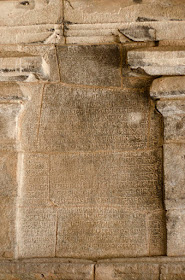Brihadeeswarar Temple – Inscriptions
Rajaraja Chola the Great was the first Chola King to
document archives of his rule in the form of written evidence on stone tablets
and copper plates.
The Big Temple is not only a magnificent edifice with
its majestic vimana, sculptures, architecture and frescoes, but also has a
wealth and richness of Tamil inscriptions engraved on stone in superb
calligraphy.
This is the only temple in the whole of India, wherein
the builder himself has left behind a very large number of inscriptions on the
temple's construction, its various parts, the daily rituals to be performed for
the Linga, the details of the offerings such as jewellery, flowers and
textiles, the special worship to be performed, the particular days on which they
should be performed, the monthly and annual festivals, and so on.”
Raja Raja Chola even appointed an astronomer called
‘Perunkani' for announcing the dates, based on the planetary movements, for
celebrating the temple's festivals.
Again, this is the only temple in India where the King
specifically mentions in an inscription that he built this all-stone temple
called ‘kattrali' (‘kal' meaning stone and ‘tali' a temple). This magnum opus,
running to 107 paragraphs, describes, among others, how Raja Raja Chola, seated
in the royal bathing hall on the eastern side of his palace, instructed how his
order should be inscribed on the base of the vimana, how he executed the
temple's plan, the list of gifts he, his sister Kundavai, his queens and others
gave to the temple.
The inscriptions provide a list of 66 beautiful bronze
idols Raja Raja Chola, Kundavai, his queens and others gifted to the temple.
The inscriptions elaborate on the enormous gold jewellery, inlaid with precious
stones such as diamonds, emeralds, sapphires, rubies, corals, pearls, for
decorating each of these bronzes.
Interestingly, the measurements of all these bronzes —
from crown to toe, the number of arms they had and the symbols they held in
their arms — are inscribed. Today, only two of these bronzes remain in the
temple — that of a dancing Siva and his consorts Sivakami. All the jewellery
has disappeared.
Even the lacquer used inside the beads and the thread
employed for stringing them together were recorded. There were references to
white pearls, red pearls, chipped ones, those with red lines or skin peeled
off.
Raja Raja Chola gifted gold vessels to the temple, and
their weight, shape and casting were mentioned in the lithic records. Even a
small spoon ‘Nei muttai,' for scooping out ghee, finds a mention. The
inscriptions throw light on the temple's revenue from various sources, the mode
of payment and the meticulous accounting procedures. “It shows the care and
attention with which the temple property was entered in the registers and the
responsibility fixed for handling them. Raja Raja Chola had an extraordinary
administrative talent, unsurpassed either before or after him.
The inscriptions even speak about the temple's cleaners,
sweepers, carriers of flags and parasols, torch-bearers for processions at
night and festivals, cooks, dancers, musicians and singers of Tamil and
Sanskrit verses.
A lot of inscriptions were carved on the basal stones of
the Brihadisvara Temple, not only praising the achievement of its builder,
Rajaraja I, but also depicting the society of the temple city, Thanjavur.
In the precincts of the Brihadisvara Temple, in addition
to hundreds of priests, there lived more than 600 people such as dancers,
flutists, drummers, Vina players, conch players, canopy holders, water sprinklers,
lamp keepers, laundry women, and so forth. These people worked for the temple
for half a day, and spent the remaining time on farm work, on land which was
lent gratis by Rajaraja I. The contract with the temple was carved on a stone.
In exchange for using the farm land, it was their duty to engage in the
construction work of the temple and to pull glittering festival cars on
festival days.
From the temple inscriptions, one can know how much
gold, silver, and jewelry, the Brihadisvara Temple possessed. The temple
financed shipbuilders, village communities, craft guilds, and so forth,
charging interest up to 30%. Even during the period of decline of the Chola
Dynasty, the temple could raise large funds for expansion and ornamentation.

























